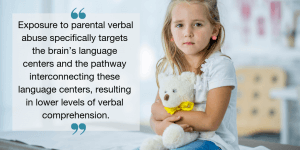
Four things you will learn from Dr. Martin Teichers’ workshop that will likely astound you
This post was written by Dr. Martin H. Teicher, M.D., Ph.D.
In Dr. Martin Teichers’ upcoming workshops with the Australian Childhood Foundation starting next month, he will be exploring many key themes in the Neuroscience of Multiple Trauma. Here are four interesting things you can expect to learn:
1. Childhood maltreatment markedly alters brain structure and function, but contrary to what many say it is not ‘damaged’, rather it is altered in very specific ways to cope with what is being experienced, though these adaptations often become maladaptive later in life.
A primary example is the way that the brain is modified by exposure to specific types of abuse. Exposure to parental verbal abuse specifically targets the brain’s language centers and the pathway interconnecting these language centers, resulting in lower levels of verbal comprehension.

Emotional abuse also targets cortical regions specifically involved in emotional regulation. Visually witnessing domestic violence, on the other hand, specifically targets visual cortex and the pathway connecting visual cortex and limbic system which helps determine our emotional and memory response to things we see. Childhood sexual abuse also targets parts of the visual system and in females specifically attenuates the development of the portion of the somatosensory cortex that processes physical sensations from the clitoris and surrounding genital area. We will explore the implications of these changes.
2. Timing of maltreatment matters.
Specifically, there are sensitive periods, or windows of vulnerability, when certain experiences will have the most powerful effects on brain development and risk for specific psychiatric disorders. In particular, we will discuss type and timing of and combinations of exposure most predictive of developing major depression, anxiety disorders, neuroticism, disagreeableness, substance use disorders as well as borderline and other personality disorders.
3. One of the most powerful effects of
maltreatment is to program how we respond to threat by modifying amygdala function and hypothalamic-pituitary-adrenal response to threat.
What we have just learned is that maltreatment can exert opposite effects on amygdala function and stress response depending on when it occurs. Briefly, exposure to early physical abuse modifies the amygdala to have a blunted response to threat while exposure to peer emotional bullying at ages 13-15 modifies the amygdala to have an enhanced response to threat.
This makes potential adaptive sense as a young child cannot marshal an effective fight or flight response and too strong a fight/flight response may interfere with the attachment bond. On the other hand, a strong fight/flight response may be quite appropriate for bullied teenagers. The consequences however of a heightened amygdala response to threat include symptoms of anxiety and inhibition as in PTSD and phobias, whereas blunted response may lead to problems with disinhibition and impaired social judgement such as in substance use and conduct disorders.
4. Our most unexpected and consequential findings have to deal with the nature of resilience and recovery in maltreated individuals.
We are all aware of individuals who have endured substantial exposure to childhood adversity who are, from a mental health perspective, doing much better than expected. Initially, we had assumed that psychiatric resilience and neurobiological resilience would go hand-in-hand and that maltreated individuals with high levels of mental health would not have experienced the same brain changes that we see in maltreated individuals with psychopathology.
That turns out not to be true as resilient individuals have the same basic array of alterations in stress-susceptible structures that we see in more susceptible maltreated individuals. Interestingly, we have identified 9 unique changes in the brains of resilient individuals (not seen in healthy controls or susceptible subjects) that enable these resilient individuals to effectively compensate for their other brain changes.
The differences are so clear that we were able, in a large sample, to predict, with impressive accuracy, whether individuals were maltreated or not and if so whether they were resilient or susceptible based on only a handful of specific brain measures.
This then leads to the nature of recovery and effect of treatment. What many have assumed is that recovery means reversing the effects of maltreatment on stress-susceptible brain structures. What we have found however, is that recovered individuals actually have the same brain organization as resilient individuals. This then provides entirely new insight into how effective treatment should work, and together we will explore this exciting new insight.
Are you interested in learning more? We are thrilled to facilitate Dr. Martin Teichers’ return to Australia for two-day workshops around the country in 2019.

